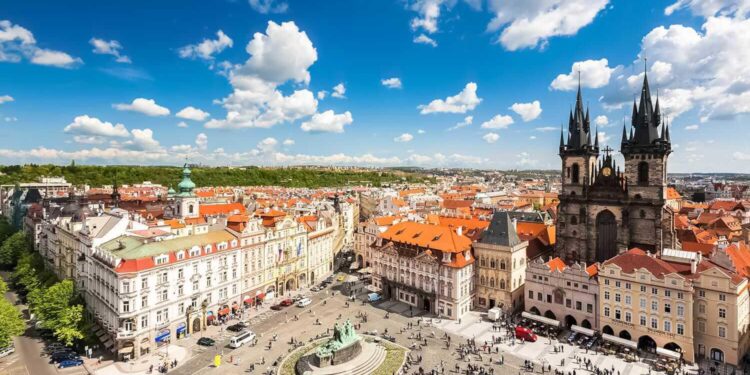Czechia, a captivating Central European gem, continues to draw travelers with its rich history, stunning architecture, and vibrant culture. As Lonely Planet highlights in its latest travel guide, the country offers a diverse array of experiences – from the fairy-tale charm of Prague’s medieval streets to the tranquil beauty of its countryside. This article delves into what makes Czechia a top destination for 2024, exploring key attractions, insider tips, and emerging travel trends identified by Lonely Planet’s experts.
Czechia’s Hidden Gems Beyond Prague
While Prague dazzles with its iconic castles and vibrant culture, the rest of Czechia offers a treasure trove of lesser-known locales that captivate with their unique charm and history. ÄŚeskĂ˝ Krumlov, a UNESCO World Heritage town, enchants visitors with its winding cobblestone streets, Renaissance and Baroque architecture, and the imposing ÄŚeskĂ˝ Krumlov Castle. Meanwhile, the spa town of Karlovy Vary invites travelers to rejuvenate in its mineral-rich thermal springs, surrounded by picturesque colonnades and grand hotels that echo the elegance of a bygone era. For nature enthusiasts, Bohemian Switzerland National Park presents breathtaking sandstone formations and lush forests perfect for hiking and photography.
Beyond the well-trodden paths, Czechia’s countryside reveals remarkable experiences worth exploring:
- TelÄŤ – Known for its Renaissance square, colorful facades, and calm lakeside setting.
- Moravian Karst – A dramatic limestone plateau featuring over 1,100 caverns and gorges, including the stunning Macocha Abyss pit.
- Olomouc – A cultural hub with a rich religious history, striking baroque fountains, and vibrant street life.
| Destination | Highlight | Best Time to Visit |
|---|---|---|
| ÄŚeskĂ˝ Krumlov | Medieval castle & river views | Late spring to early autumn |
| Karlovy Vary | Healing thermal springs | Year-round, especially winter |
| Bohemian Switzerland | Sandstone formations & hiking | Summer for trails, winter for solitude |
Exploring Traditional Czech Cuisine in Local Markets
Wandering through the lively local markets of Czechia is a sensory journey that offers an authentic taste of the nation’s rich culinary heritage. Stalls bursting with vibrant seasonal produce, fragrant herbs, and freshly baked pastries invite visitors to indulge in traditional flavors. Karlovy Vary’s market, for example, showcases an array of regional specialties like koláče (sweet filled pastries) and smoked cheeses, while Prague’s HavelskĂ© trĹľištÄ› offers a colorful spectrum of pickled vegetables, sausages, and artisan breads. These bustling hubs reveal not only the importance of fresh, local ingredients in Czech cooking but also the country’s deep-rooted tradition of communal food sharing.
For those seeking to recreate Czech dishes at home or simply savor new tastes, market vendors often share stories behind their products, from the centuries-old recipes of svĂÄŤková sauce to the hand-crafted beers brewed in small batches. Below is a snapshot of must-try staples commonly found in local markets, essential for an immersive gastronomic experience:
- TrdelnĂk: Sweet, rolled dough sprinkled with sugar and walnuts.
- ChlebĂÄŤky: Open-faced sandwiches topped with cured meats and pickles.
- KnedlĂky: Traditional bread dumplings served with rich meat dishes.
- Becherovka: Herbal liqueur known as the spirit of Czechia.
- PalaÄŤinky: Thin pancakes filled with fruit or chocolate.
| Dish | Main Ingredients | Market Of Origin |
|---|---|---|
| Goulash | Beef, onion, paprika | Prague |
| Smažený sýr | Fried cheese, tartar sauce | Brno |
| Moravian Wine | Locally grown grapes | South Moravia |
Navigating Public Transport for Seamless City Hopping
Mastering the public transport system in Czechia is key to experiencing the country’s urban and rural charms without hassle. Major cities like Prague, Brno, and Ostrava boast extensive networks of trams, buses, and metro lines, all synchronized to offer frequent and reliable service. City tickets and passes provide flexible options for visitors who plan to jump between multiple locations, with travel permits often available in convenient digital formats. For night owls, many cities operate night buses, making late arrivals or early departures smooth. Additionally, regional trains connect urban centers with smaller towns, ensuring that even off-the-beaten-path destinations remain accessible.
- Praha: Integrated metro, tram, and bus services with clear signage in English.
- Brno: Efficient trolleybus lines complement the bus and tram routes.
- Regional Trains: Czech Railways (ÄŚD) offer frequent intercity connections.
Planning a seamless transition between different modes of transport is simpler when using apps like IDOS or the official city transport websites, which provide real-time schedules and platform information. For international travelers, ticket pricing typically falls into economical tiers, making spontaneous day trips both affordable and convenient. Below is a sample overview of average journey times and costs, highlighting the ease of moving through the Czech Republic’s diverse urban landscape:
| Route | Transport Mode | Average Duration | Approximate Cost (CZK) |
|---|---|---|---|
| Prague City Centre to Vyšehrad | Metro + Tram | 20 min | 24 |
| Brno Central to Ĺ pilberk Castle | Tram | 15 min | 18 |
| Prague to ÄŚeskĂ˝ Krumlov | Train + Bus | 3 hrs | 250 |
Closing Remarks
As Czechia continues to captivate travelers with its blend of historic charm and vibrant modern culture, Lonely Planet’s comprehensive guide offers an essential resource for those looking to explore this Central European gem. Whether wandering the cobblestone streets of Prague, hiking the scenic Bohemian countryside, or sampling traditional cuisine, visitors can rely on expert insights to enhance their journey. With its rich heritage and welcoming atmosphere, Czechia remains a top destination for discerning travelers seeking both adventure and authenticity.
















